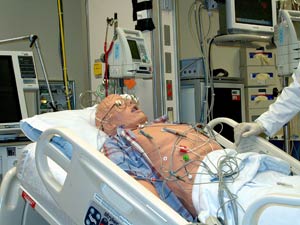|
Audio
Photos
|
 |
| The Mayo Clinic's new Multidisciplinary Simulation Center allows medical staff to experience complicated medical situations by using special mannequins. (MPR photo/Sea Stachura) |
Rochester, Minn. — Dr. Pritish Tosh is leaning over his patient, listening to his heart.
"Do you smoke?" he asks.
"No." The answer sounds like a synthesized groan.
Tosh is a live human resident at Mayo. But his patient is a rubber mannequin, and a very sick one at that.
"I'm concerned your having a heart attack," Tosh says as he reaches to check for a pulse.
"Oh gosh!"
Tosh immediately begins C.P.R. He's watched by the clinic's medical director Dr. William Dunn.
Dunn says the clinic's goal is to prepare doctors, nurses and students for complicated medical situations. Mayo has created six simulated emergency and patient rooms built with teaching in mind.
"So we can do the team training that has to happen across specialty areas and do it in dynamic sense and do it in a way that its captured on camera video and replayed rehearsed and retrained around," Dunn says.
Back at the hospital bed the mannequin is getting oxygen from the nurse. She asks the patient to rate on a scale of one to 10 how much pain he is feeling, then she gives him an injection based on the answer.
To make the situation even more real, a nurse playing the patient's daughter enters.
"I just came down. I work here," she says settling into the role.
The mannequins don't appear terribly complicated from the outside. But the Center's administrator Kay Thiemann says these are not the simple mannequins from your Red Cross C-P-R days.
"They have the same human physiology that we do actually and they can breathe. They have a pulse. Their pupils dilate, they can urinate. They can do all sorts of things.
The dummies also speak and blink. They have clothing and can be quickly switched from male to female.
They're hardwired to the center's network, so instructors in a remote control room adjusts the heart rate, and response to medicines. The clinic has six of these models. The most expensive costs a quarter million dollars.
The center also sports what amounts to a medical video game room. Thiemann says a surgical resident can practice making incisions on a virtual patient through a video game.
"Say for example you're cutting through tissue," she says. "Or you're excising something and you hit an artery, or you hit something that you shouldn't be. Or you cut through something that you shouldn't, the monitors will tell you just like they would in a OR whether or not you've hurt the patient."
So far Dr. Tosh hasn't done any damage to his patient. But he's suddenly stopped breathing.
"Sir? Are you with me? Dad? Dad!"
In the end Tosh's patient stabilizes and goes off to surgery.
This is Tosh's first experience with the high-tech mannequins. As a third year resident he's worked on many live patients. But he says he's learned a lot in the last few minutes.
"The difference here is that you're freer to make mistakes," he says. "I mean they can throw out difference situations and see how you react to them and make sure you're prepared for them without having to endanger real patients."
The center opened in October. So far they've trained over 400 people in the new center.







